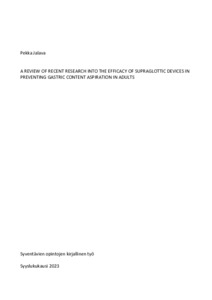A review of recent research into the efficacy of supraglottic devices in preventing gastric content aspiration in adults
Jalava, Pekka (2023-09-04)
A review of recent research into the efficacy of supraglottic devices in preventing gastric content aspiration in adults
Jalava, Pekka
(04.09.2023)
Julkaisu on tekijänoikeussäännösten alainen. Teosta voi lukea ja tulostaa henkilökohtaista käyttöä varten. Käyttö kaupallisiin tarkoituksiin on kielletty.
avoin
Julkaisun pysyvä osoite on:
https://urn.fi/URN:NBN:fi-fe20231027141660
https://urn.fi/URN:NBN:fi-fe20231027141660
Tiivistelmä
Aspiration of gastric contents is considered one of the most serious anaesthesia-related complications. Second-generation supraglottic airway devices (SGAs) are standard practice in modern operating room anaesthesia, resuscitation, and pre-hospital care. However, endotracheal intubation is still considered as the golden standard in high-aspiration-risk patients. This review surveyed recent literature regarding the risk of aspiration when using second-generation SGAs.
A literature search was performed using total of six databases. Exclusion criteria included: studies based on manikins, cadavers, or animals; studies conducted on solely paediatric patients; studies where clinical aspiration was not an outcome; studies where only first-generation SGAs were used. Data points extracted from included studies: specific SGA model used, whether SGA was compared to intubation or other SGAs, the surgical procedure, the patient characteristics of ASA physical status, age, gender, BMI, and whether there was preoperative knowledge of particular risks of aspiration, how aspiration was identified and defined, and the sample size.
A total of 26 studies were included in the analysis. No statistically significant difference between SGA types or results favouring endotracheal tube over SGA was found in these studies. In conclusion, there doesn't appear to be a risk difference between different SGAs — or potentially even between SGAs and the endotracheal tube when administering anaesthesia to adults for elective operations or in an emergency setting.
A literature search was performed using total of six databases. Exclusion criteria included: studies based on manikins, cadavers, or animals; studies conducted on solely paediatric patients; studies where clinical aspiration was not an outcome; studies where only first-generation SGAs were used. Data points extracted from included studies: specific SGA model used, whether SGA was compared to intubation or other SGAs, the surgical procedure, the patient characteristics of ASA physical status, age, gender, BMI, and whether there was preoperative knowledge of particular risks of aspiration, how aspiration was identified and defined, and the sample size.
A total of 26 studies were included in the analysis. No statistically significant difference between SGA types or results favouring endotracheal tube over SGA was found in these studies. In conclusion, there doesn't appear to be a risk difference between different SGAs — or potentially even between SGAs and the endotracheal tube when administering anaesthesia to adults for elective operations or in an emergency setting.
